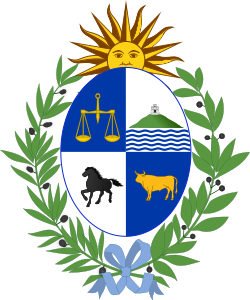 |
|---|
Parliamentary elections were held in Uruguay on 28 November 1910 to elect all members of the Chamber of Representatives and 7 of the 19 members of the Senate. [1] The main opposition, the National Party did not contest the elections. [1] [2]
 |
|---|
Parliamentary elections were held in Uruguay on 28 November 1910 to elect all members of the Chamber of Representatives and 7 of the 19 members of the Senate. [1] The main opposition, the National Party did not contest the elections. [1] [2]
The elections were the first held after the introduction of the double simultaneous vote system under law 3640. [1]
Suffrage was limited to literate men. Voting was not secret, as voters had to sign their ballot paper. [3]
 | |||||
|---|---|---|---|---|---|
| Party | Votes | % | Seats | +/– | |
| Colorado Party | 26,787 | 86.75 | 85 | +16 | |
| Liberal Coalition | 3,594 | 11.64 | 5 | New | |
| Catholic Party | 497 | 1.61 | 0 | New | |
| Total | 30,878 | 100.00 | 90 | +6 | |
| Source: Bottinelli et al. [1] | |||||
| Party | Votes | % | Seats | |
|---|---|---|---|---|
| Colorado Party | 14,175 | 90.98 | 7 | |
| Liberal Coalition | 1,063 | 6.82 | 0 | |
| Catholic Party | 342 | 2.20 | 0 | |
| Total | 15,580 | 100.00 | 7 | |
| Source: Bottinelli et al. [1] | ||||
Following the elections, members of parliament elected José Batlle y Ordóñez as president on 1 March 1911. [1]